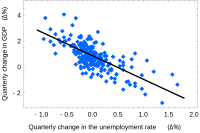Variance of the mean and predicted responses

Okay kiddo, let's talk about variance of the mean and predicted responses!
Imagine you have a big bowl of candy, and you want to know how much each piece weighs. So you weigh 10 pieces of candy and find out that they weigh 1 gram, 3 grams, 2 grams, 4 grams, 3 grams, 2 grams, 4 grams, 1 gram, 2 grams, and 3 grams.
Now, you want to know what the average weight of the candy is. So you add up all the weights of the 10 pieces of candy and get a total weight of 23 grams. Then, you divide 23 by 10 to get the average weight, which is 2.3 grams.
But wait, there's more we can do with this information! We can use the average weight to predict what the weight of a piece of candy will be if we pick it randomly from the bowl.
However, we also want to know how accurate our prediction will be. This is where variance of the mean comes in. Variance is a fancy way of saying how spread out the data is.
In our candy example, we can calculate the variance by finding the difference between each weight and the average weight, squaring those differences, adding them up, and then dividing by the number of pieces of candy we weighed minus 1. This gives us a variance of 1.21 grams.
So, what does this mean? It means that there is a range of weights that the candy could be, and that range is about 1.1 grams on either side of the average weight. This is called the standard deviation, and it tells us how much the weights of the candy vary from each other.
Now, let's talk about predicted responses. This is a term that is often used in statistics. Predicted responses are what we think will happen based on the data we have collected.
Going back to our candy example, we can use the average weight of 2.3 grams to predict what the weight of any one piece of candy is likely to be. This is our predicted response.
However, we need to keep in mind the variance we calculated earlier. Because the weights of the candy vary from each other, our predicted response is not always going to be exactly right. In fact, it is likely that the weight of any given piece of candy will be somewhere within the range of weights we calculated earlier.
So, when we make a prediction based on our data, we need to keep in mind the variance and potential error in our prediction. This way, we can have a better understanding of the accuracy of our predictions.
I hope that helps explain variance of the mean and predicted responses, kiddo!
Imagine you have a big bowl of candy, and you want to know how much each piece weighs. So you weigh 10 pieces of candy and find out that they weigh 1 gram, 3 grams, 2 grams, 4 grams, 3 grams, 2 grams, 4 grams, 1 gram, 2 grams, and 3 grams.
Now, you want to know what the average weight of the candy is. So you add up all the weights of the 10 pieces of candy and get a total weight of 23 grams. Then, you divide 23 by 10 to get the average weight, which is 2.3 grams.
But wait, there's more we can do with this information! We can use the average weight to predict what the weight of a piece of candy will be if we pick it randomly from the bowl.
However, we also want to know how accurate our prediction will be. This is where variance of the mean comes in. Variance is a fancy way of saying how spread out the data is.
In our candy example, we can calculate the variance by finding the difference between each weight and the average weight, squaring those differences, adding them up, and then dividing by the number of pieces of candy we weighed minus 1. This gives us a variance of 1.21 grams.
So, what does this mean? It means that there is a range of weights that the candy could be, and that range is about 1.1 grams on either side of the average weight. This is called the standard deviation, and it tells us how much the weights of the candy vary from each other.
Now, let's talk about predicted responses. This is a term that is often used in statistics. Predicted responses are what we think will happen based on the data we have collected.
Going back to our candy example, we can use the average weight of 2.3 grams to predict what the weight of any one piece of candy is likely to be. This is our predicted response.
However, we need to keep in mind the variance we calculated earlier. Because the weights of the candy vary from each other, our predicted response is not always going to be exactly right. In fact, it is likely that the weight of any given piece of candy will be somewhere within the range of weights we calculated earlier.
So, when we make a prediction based on our data, we need to keep in mind the variance and potential error in our prediction. This way, we can have a better understanding of the accuracy of our predictions.
I hope that helps explain variance of the mean and predicted responses, kiddo!
Related topics others have asked about:
